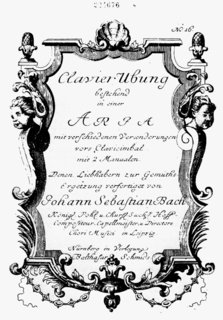This article needs additional citations for verification .(April 2010) (Learn how and when to remove this template message) |
Clavier-Übung, in more modern spelling Klavierübung, is German for "keyboard exercise". In the late 17th and early 18th centuries this was a common title for keyboard music collections: first adopted by Johann Kuhnau in 1689, [1] [2] the term later became mostly associated with Johann Sebastian Bach's four Clavier-Übung publications. [1]

German is a West Germanic language that is mainly spoken in Central Europe. It is the most widely spoken and official or co-official language in Germany, Austria, Switzerland, South Tyrol (Italy), the German-speaking Community of Belgium, and Liechtenstein. It is also one of the three official languages of Luxembourg and a co-official language in the Opole Voivodeship in Poland. The languages which are most similar to German are the other members of the West Germanic language branch: Afrikaans, Dutch, English, the Frisian languages, Low German/Low Saxon, Luxembourgish, and Yiddish. There are also strong similarities in vocabulary with Danish, Norwegian and Swedish, although those belong to the North Germanic group. German is the second most widely spoken Germanic language, after English.

Johann Kuhnau was a German polymath: known primarily as composer today, he was also active as novelist, translator, lawyer, and music theorist, being able late in life to combine these activities with the duties of his official post of Thomaskantor in Leipzig, which he occupied for 21 years. Much of his music, including operas, masses, and other large-scale vocal works, is lost. His reputation today rests on a set of programmatic keyboard sonatas published in 1700, in which each sonata depicted in detail a particular story from the Bible. After his death, Kuhnau was succeeded as Thomaskantor by Johann Sebastian Bach.

Johann Sebastian Bach was a German composer and musician of the Baroque period. He is known for instrumental compositions such as the Art of Fugue, the Brandenburg Concertos, and the Goldberg Variations as well as for vocal music such as the St Matthew Passion and the Mass in B minor. Since the 19th-century Bach Revival he has been generally regarded as one of the greatest composers of all time.
Contents
The following composers published works under the title Clavier-Übung:
- Johann Sebastian Bach: [1] [2]
- Clavier-Übung I : six partitas, published separately 1726–1730, then grouped in one volume in 1731
- Clavier-Übung II : Italian Concerto and French Overture (1735)
- Clavier-Übung III : also known as the German Organ Mass (1739)
- Clavier-Übung IV: Aria with Diverse Variations, known as the Goldberg Variations (1741)

The Goldberg Variations, BWV 988, is a musical composition for harpsichord by Johann Sebastian Bach, consisting of an aria and a set of 30 variations. First published in 1741, the work is one of the most important examples of the variation form. It is named after Johann Gottlieb Goldberg, who may also have been the first performer of the work.
- Ferruccio Busoni
- Klavierübung (1918–1925)
- Christoph Graupner:
- Leichte Clavier-Übungen (c.1730)
- Johann Ludwig Krebs
- Clavier Ubung Bestehend in verschiedenen vorspielen und veränderungen einiger Kirchen Gesaenge Nürnberg, J.U. Haffner, c. 1744)
- Clavier-Ubung bestehet in einer [...] Suite [...] Zweyter Theil (Nürnberg, J.U. Haffner, c. 1744)
- Clavier-Ubung bestehend in sechs Sonatinen … IIIter Theil (Nürnberg, J.U. Haffner, c. 1744)
- Johann Philipp Kirnberger
- Clavierübungen mit der bachischen Applicatur , four volumes, 1761–1766
- Johann Krieger
- Anmuthige Clavier-Übung (1698)
- Johann Kuhnau: [1] [2]
- Neuer Clavier-Übung, erster Theil (1689)
- Neuer Clavier-Übung, anderer Theil (1692)
- Vincent Lübeck
- Clavier Übung (1728)
- Georg Andreas Sorge
- Clavier Übung in three parts, 18 sonatas for harpsichord (1738–c.1745)
- Clavier Übung in two parts, 24 preludes for organ or clavichord (1739–42)
Johann Sebastian Bach's Clavier-Übung II was published in 1735, containing two works written for performance on a two-manual harpsichord. In the publication, Bach contrasted a work in Italian style – a Concerto nach Italienischem Gusto, BWV 971, with a work in French style, a suite which he called Ouvertüre nach franzosischer Art, BWV 831.
The Overture in the French style, BWV 831, original title Ouvertüre nach Französischer Art, also known as the French Overture and published as the second half of Clavier-Übung II in 1735, is a suite in B minor for two-manual harpsichord written by Johann Sebastian Bach. An earlier version of this work exists, in the key of C minor ; the work was transposed into B minor to complete the cycle of tonalities in Parts One and Two of the Clavier-Übung. The keys of the six Partitas form a sequence of intervals going up and then down by increasing amounts: a second up, a third down, a fourth up, a fifth down, and finally a sixth up. The key sequence continues into Clavier-Übung II (1735) with two larger works: the Italian Concerto, a seventh down, and the French Overture, an augmented fourth up. Thus this sequence of customary tonalities for 18th-century keyboard compositions is complete, extending from the first letter of his name to the last letter of his name.

The Clavier-Übung III, sometimes referred to as the German Organ Mass, is a collection of compositions for organ by Johann Sebastian Bach, started in 1735–36 and published in 1739. It is considered Bach's most significant and extensive work for organ, containing some of his most musically complex and technically demanding compositions for that instrument.





